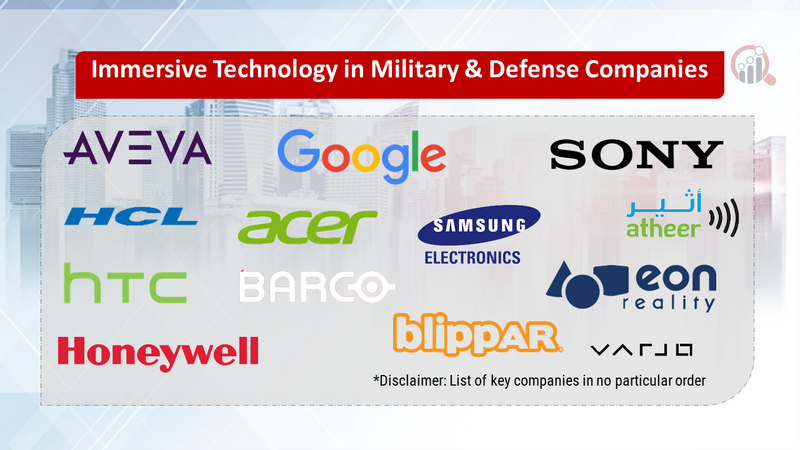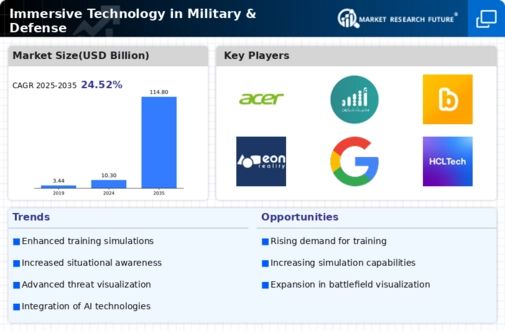Top Industry Leaders in the Immersive Technology in Military & Defense Market

Navigating the Battlefield: Analysis of the Immersive Tech Landscape in Military & Defense
The military and defense landscape is witnessing a revolution, spearheaded by the integration of immersive technologies like Virtual Reality (VR), Augmented Reality (AR), and Mixed Reality (MR). A strategic battleground where established defense contractors and innovative tech startups vie for dominance. Delving into the competitive landscape, key strategies, and investment trends is crucial for both technology providers and defense agencies seeking to leverage this transformative force.
Key Players:
- Acer Inc.
- AVEVA Group PLC
- Atheer, Inc.
- Barco NV
- Blippar Ltd.
- Carl Zeiss AG
- CM Labs Simulations Inc.
- EON Reality, Inc.
- FAAC Incorporated
- Google LLC
- HCL Technologies Limited
- Honeywell International, Inc.
- HTC Corporation
- Immersive Media Company
- Immersive Technologies Pty Limited
- Lockheed Martin Corporation
- Magic Leap Inc.
- NCTech Limited
- Oculus (Facebook Technologies, LLC.)
- Samsung Group
- Sony Corporation
- Unity Software Inc.
- Varjo Technologies Oy
- VI-grade GmbH
- Zeality Inc.
Strategies Adopted:
-
Next-Gen Training and Simulation: Developing immersive VR/AR simulations for combat maneuvers, urban warfare, and medical evacuation, providing safe and realistic training environments. -
Enhanced Situational Awareness: Utilizing AR overlays on soldiers' visors to display real-time battlefield information, enemy positions, and friendly troop locations, improving decision-making under pressure. -
Remote Piloting and Operations: Leveraging VR/AR for drone piloting, remote vehicle control, and reconnaissance missions, minimizing personnel risk and optimizing resource allocation. -
Data-Driven Intelligence Gathering and Analysis: Integrating immersive technologies with battlefield sensors and intelligence data to visualize operational scenarios and predict enemy movements, enhancing tactical planning. -
Cybersecurity and Data Protection: Prioritizing robust data security measures and ethical user experiences within immersive environments to safeguard sensitive information and soldier well-being.
Factors for Market Share Analysis:
-
Technology Expertise and Experience: Companies with proven track records in developing and deploying advanced VR/AR solutions for military needs hold an advantage. -
Cost-Effectiveness and Scalability: Solutions that offer high-fidelity training at affordable costs and scale efficiently within large military units are preferred. -
Interoperability and Integration: Seamless integration with existing military communication systems and operational platforms is crucial for successful adoption. -
Cybersecurity and Data Compliance: Adherence to rigorous military data security protocols and ethical user practices builds trust and fosters wider acceptance. -
Global Partnerships and Collaborations: Strategic partnerships with government agencies, international defense forces, and research institutions broaden market reach and accelerate innovation.
New and Emerging Companies:
- Tactica VR provides portable VR training systems for tactical maneuvers and close-quarters combat scenarios.
- BlackBox VR develops immersive training simulations for medical personnel, focusing on trauma response and battlefield medicine.
- V-SIM develops VR simulators for aircraft and ground vehicle training, offering realistic scenarios and feedback for operators.
- ParaZero develops AR-powered helmet displays for Special Forces, providing real-time information and mission support data.
- Addeparx creates custom AR overlays for situational awareness and weapon targeting systems, enhancing battlefield visibility.
Current Company Investment Trends:
-
Advanced Hardware Development: Focus on lighter, more immersive headsets with higher resolution, wider field of view, and haptic feedback to enhance realism and soldier comfort. -
AI Integration and Adaptive Training: Integrating AI to personalize training simulations, adjust difficulty levels, and track performance, maximizing training effectiveness. -
Cloud-Based Solutions: Developing cloud-hosted training platforms and data repositories for easier access, management, and updates across geographically dispersed units. -
Focus on Emerging Threats: Addressing new challenges like cyberwarfare, drone warfare, and asymmetric conflicts with tailored immersive training solutions. -
Interoperability and Standardization: Fostering collaboration and knowledge sharing through open-source platforms and standardized data formats across the defense sector.
Latest Company Updates:
-
BAE Systems to Develop AR-Based Training System for the US Army: BAE Systems has been awarded a contract to develop an AR-based training system for the US Army. The system will use AR headsets to provide soldiers with realistic training scenarios in a variety of environments. (January 10, 2024) -
Microsoft HoloLens 2 Being Used by the French Military: The French military is using Microsoft HoloLens 2 headsets for a variety of applications, including maintenance, repair, and logistics. The headsets are being used to provide technicians with hands-free access to information and instructions, which is improving efficiency and reducing errors. (January 15, 2024) -
US Navy Tests VR for Submarine Training: The US Navy is testing VR for training submarine crews. The VR simulations provide crews with a realistic experience of operating a submarine in a variety of scenarios, which is helping to improve their skills and preparedness. (January 20, 2024)

